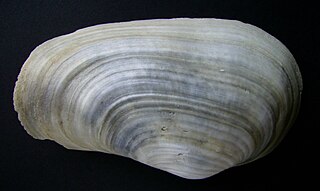
Balaenoptera is a genus of rorquals containing eight extant species. Balaenoptera comprises all but two of the extant species in its family ; the genus is currently polyphyletic, with the two aforementioned species being phylogenetically nested within it.

Pseudodiadematidae are members of the phylum Echinodermata. Their fossil remains date to the Cretaceous period. Its child geniuses are Acanthechinopsis, Acrocidaris, Acrotiaris and Aplodiadema. The distribution of fossils in the Cretaceous are in Algeria, Brazil, Egypt, France, Hungary, Jordan, Madagascar, Morocco, Nigeria, Peru, Portugal, Saudi Arabia, Spain, Switzerland, the United Arab Emirates, the United Kingdom, United States (Texas), and Yemen. In the Jurassic to Cretaceous it is found in China. In the Jurassic found in Ethiopia, France, Germany, India, Luxembourg, Morocco, Poland, Portugal, Saudi Arabia, Somalia, Switzerland, and the United Kingdom.

Panopea is a genus of large marine bivalve molluscs or clams in the family Hiatellidae. There are 10 described species in Panopea. Many of them are known under the common name "geoduck".

Chelotriton is an extinct genus of prehistoric salamanders that lived in Europe and Central Asia during the Neogene. It closely resembles the extant genera Tylototriton and Echinotriton.
The South American land mammal ages (SALMA) establish a geologic timescale for prehistoric South American fauna beginning 64.5 Ma during the Paleocene and continuing through to the Late Pleistocene. These periods are referred to as ages, stages, or intervals and were established using geographic place names where fossil materials where obtained.
The Deseadan age is a period of geologic time within the Oligocene epoch of the Paleogene to the Early Miocene epoch of the Neogene, used more specifically within the SALMA classification of South America. It follows the Tinguirirican and precedes the Colhuehuapian age.
The Colhuehuapian age is a period of geologic time within the Early Miocene epoch of the Neogene, used more specifically within the SALMA classification in South America. It follows the Deseadan and precedes the Santacrucian age.
The Laventan age is a period of geologic time within the Middle Miocene epoch of the Neogene, used more specifically within the SALMA classification in South America. It follows the Colloncuran and precedes the Mayoan age.

Cynelos is a large extinct genus of amphicyonids which inhabited North America, Europe, and Africa from the Early Miocene subepoch to the Late Miocene subepoch 20.4—13.7 Mya, existing for approximately 6 million years.
Laura Lee Kiessling is an American chemist and the Novartis Professor of Chemistry at the Massachusetts Institute of Technology. Kiessling's research focuses on elucidating and exploiting interactions on the cell surface, especially those mediated by proteins binding to carbohydrates. Multivalent protein-carbohydrate interactions play roles in cell-cell recognition and signal transduction. Understanding and manipulating these interactions provides tools to study biological processes and design therapeutic treatments. Kiessling's interdisciplinary research combines organic synthesis, polymer chemistry, structural biology, and molecular and cell biology.

Spatangus is a genus of heart urchins in the Spatangidae family. The genus is synonymous with the previously recognised genera Prospatangus Lambert, 1902 and Spatagus. There are nine recognised species. The type species is Spatangus purpureus Müller, 1776 by subsequent designation.

Chelonoidis is a genus of turtles in the tortoise family erected by Leopold Fitzinger in 1835. They are found in South America and the Galápagos Islands, and formerly had a wide distribution in the West Indies.

Hemicidaridae is a family of extinct sea urchins characterized by large, massive, club-shaped spines.

Boreostemma is an extinct genus of glyptodonts from northern South America. Fossils assigned to the genus were first described as belonging to Asterostemma from southern South America, but have been placed in the new genus Boreostemma by Carlini et al. in 2008. The type species is B. pliocena. Fossils of Boreostemma have been found in the Honda Group of Colombia, in Peru and Venezuela.
Myrmecioptychium is an extinct lychniscosidan hexasterophoran sea sponge, which is a subgenus of Coeloptychium. Its remains have been found in Santonian-Maastrichtian-aged deposits in Broitzem, Germany and Poland. The type species, M. bodei, was named in 1912.
Schizasteridae is a family of echinoderms belonging to the order Spatangoida.









